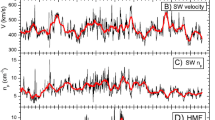Abstract
The paleo-cosmic ray records are used to study the properties of the heliosphere and solar processes over the past 9300 years. They show that both varied greatly over that time, ranging from ∼26 “Grand Minima” of duration 50–100 yr when the Sun was inactive, to periods similar to the past 50 years of strong solar activity. This shows that the detailed information regarding the heliosphere gained during the “space era” represents an extreme case, and is not representative of the majority of the past 9300 yr. The data confirm that the 11 and 22-year cycles of solar activity continued through the Spoerer and Maunder Grand Minima. Throughout the 9300 yr interval, “Grand Minima” usually occurred in groups of 2 to 4, similar to the group of four that occurred in the interval 1000–1800 AD. The groups are separated by ∼1000 yr intervals without Grand Minima. Frequency spectra of the full 9300 yr record show that the heliospheric and solar phenomena exhibit >10 well-defined and persistent periodicities. We speculate that the solar dynamo exhibits a 2300 yr periodicity, wherein it alternates between two different states of activity. In the first (∼800 yr duration) solar activity weakens greatly every 100–200 yr resulting in a sequence of Grand Minima, while in the other, the solar dynamo suffers smaller changes; the centenary scale solar and heliospheric changes are smaller, being similar to those that occurred in the interval 1890–1910. The paleo-cosmic ray evidence suggests that the Sun has now entered this more uniform period of activity, following the sequence of Grand Minima (Wolf, Spoerer, Maunder, and Dalton) that occurred between 1000 and 1800 AD.











Similar content being viewed by others
References
J. Beer, S. Tobias, N. Weiss, An active sun throughout the Maunder Minimum. Solar Phys. 181, 237–249 (1998)
J. Beer, K. McCracken, R. von Steiger, Cosmogenic Radionuclides: Theory and Applications in the Terrestrial and Space Environments (Springer, Berlin, 2011)
R.A. Caballero-Lopez, H. Moraal, Limitations of the force field equation to describe cosmic ray modulation. J. Geophys. Res. 109, A01101 (2004). doi:10.1029/2003JA010098
R.A. Caballero-Lopez, H. Moraal, K.G. McCracken, F.B. McDonald, The heliospheric magnetic field from 850 to 2000 AD inferred from 10Be records. J. Geophys. Res. 109(A12), 12102 (2004). doi:10.1029/2004JA010633
L.J. Gleeson, W.I. Axford, Cosmic rays in the interplanetary medium. Astrophys. J. 149, 115–118 (1967)
J.R. Jokipii, Variations of the cosmic-ray flux with time, in The Sun in Time, ed. by C.P. Sonett, H.S. Giampapa, M.S. Mathews (University of Arizona Press, Tucson, 1991), pp. 205–220
J. Masarik, J. Beer, Simulation of particle fluxes and cosmogenic nuclide production in the Earth’s atmosphere. J. Geophys. Res. 104, 12099–12111 (1999)
K.G. McCracken, Geomagnetic and atmospheric effects upon the cosmogenic 10Be observed in polar ice. J. Geophys. Res. 109, A04101 (2004). doi:10.1029/2003JA010060
K.G. McCracken, Heliomagnetic field near Earth, 1428–2005. J. Geophys. Res. 112, A09106 (2007). doi:10.1029/2006JA012119
K.G. McCracken, J. Beer, Long term changes in the cosmic ray intensity at Earth, 1428–2005. J. Geophys. Res. 112, A10101 (2007). doi:10.1029/2006JA012117
K.G. McCracken, J. Beer, F.B. McDonald, Variations in the cosmic radiation, 189–1986, and the solar and terrestrial implications. Adv. Space Res. 34, 397–406 (2004a)
K.G. McCracken, F.B. McDonald, J. Beer, G. Raisbeck, F. Yiou, A phenomenological study of the long-term cosmic ray modulation, 850–1950 AD. J. Geophys. Res. 109, A12103 (2004b). doi:10.1029/2004JA010685
R. Muscheler, J. Beer, P.W. Kubik, H.-A. Synal, Geomagnetic field intensity during the last 60,000 years based on 10Be & 36Cl from the Summit ice cores and 14C. Quat. Sci. Rev. 24, 1849–1860 (2005)
C.P. Sonett, Very long solar periods and the radiocarbon record. Rev. Geophys. 22, 239–254 (1984)
F. Steinhilber, J.A. Abreu, J. Beer, K.G. McCracken, The interplanetary magnetic field during the past 9300 years inferred from cosmogenic radionuclides. J. Geophys. Res. 115, A01104 (2010). doi:10.1029/2009JA014193
I.G. Usoskin, K. Mursala, G.A. Kovaltsov, Heliospheric modulation of cosmic rays and solar activity during the Maunder Minimum. J. Geophys. Res. 106, 16039–16046 (2001)
W.R. Webber, P.R. Higbie, A comparison of new calculations of 10Be production in the earth’s polar atmosphere by cosmic rays with 10Be concentration measurements in polar ice cores between 1939–2005—A troubling lack of concordance, paper 1, http://arxiv.org/abs/1003.4989; and paper 2 with C.W. Webber, http://arxiv.org/abs/1004.2675
Acknowledgements
The research at the University of Maryland was supported by NSF grant ATM 0107181. The support of the International Space Science Institute, of Bern, Switzerland is gratefully acknowledged.
Author information
Authors and Affiliations
Corresponding author
Rights and permissions
About this article
Cite this article
McCracken, K., Beer, J., Steinhilber, F. et al. The Heliosphere in Time. Space Sci Rev 176, 59–71 (2013). https://doi.org/10.1007/s11214-011-9851-3
Received:
Accepted:
Published:
Issue Date:
DOI: https://doi.org/10.1007/s11214-011-9851-3




